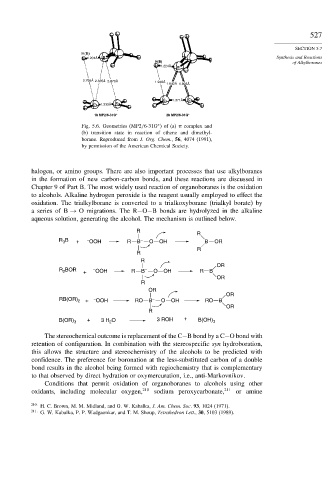Page 546 - Advanced Organic Chemistry Part A - Structure and Mechanisms, 5th ed (2007) - Carey _ Sundberg
P. 546
527
SECTION 5.7
H(B)
1.201Å B Synthesis and Reactions
H(B) of Alkylboranes
1.224Å B
2.766Å 2.835Å 2.873Å
1.946Å
1.942Å 1.893Å
C 1 1.371Å C 2
C 1 1.339Å C 2
1b MP2/6-31G* 2b MP2/6-31G*
Fig. 5.6. Geometries (MP2/6-31G )of(a) complex and
∗
(b) transition state in reaction of ethene and dimethyl-
borane. Reproduced from J. Org. Chem., 56, 4074 (1991),
by permission of the American Chemical Society.
halogen, or amino groups. There are also important processes that use alkylboranes
in the formation of new carbon-carbon bonds, and these reactions are discussed in
Chapter 9 of Part B. The most widely used reaction of organoboranes is the oxidation
to alcohols. Alkaline hydrogen peroxide is the reagent usually employed to effect the
oxidation. The trialkylborane is converted to a trialkoxyborane (trialkyl borate) by
a series of B → O migrations. The R−O−B bonds are hydrolyzed in the alkaline
aqueous solution, generating the alcohol. The mechanism is outlined below.
R
R
R B + – OOH R B – O OH B OR
3
R
R
R
OR
R BOR + – OOH R B – O OH R B
2
OR
R
OR
OR
RB(OR) 2 + – OOH RO B – O OH RO B
OR
R
B(OR) 3 + 3 H O 3 ROH + B(OH) 3
2
The stereochemical outcome is replacement of the C−B bond by a C−O bond with
retention of configuration. In combination with the stereospecific syn hydroboration,
this allows the structure and stereochemistry of the alcohols to be predicted with
confidence. The preference for boronation at the less-substituted carbon of a double
bond results in the alcohol being formed with regiochemistry that is complementary
to that observed by direct hydration or oxymercuration, i.e., anti-Markovnikov.
Conditions that permit oxidation of organoboranes to alcohols using other
oxidants, including molecular oxygen, 210 sodium peroxycarbonate, 211 or amine
210 H. C. Brown, M. M. Midland, and G. W. Kabalka, J. Am. Chem. Soc. 93, 1024 (1971).
211
G. W. Kabalka, P. P. Wadgaonkar, and T. M. Shoup, Tetrahedron Lett., 30, 5103 (1989).

